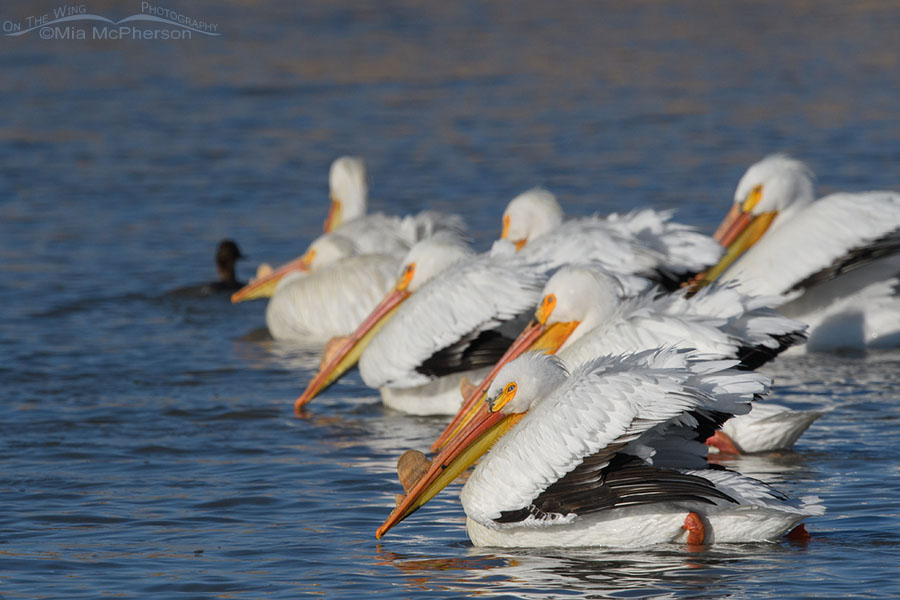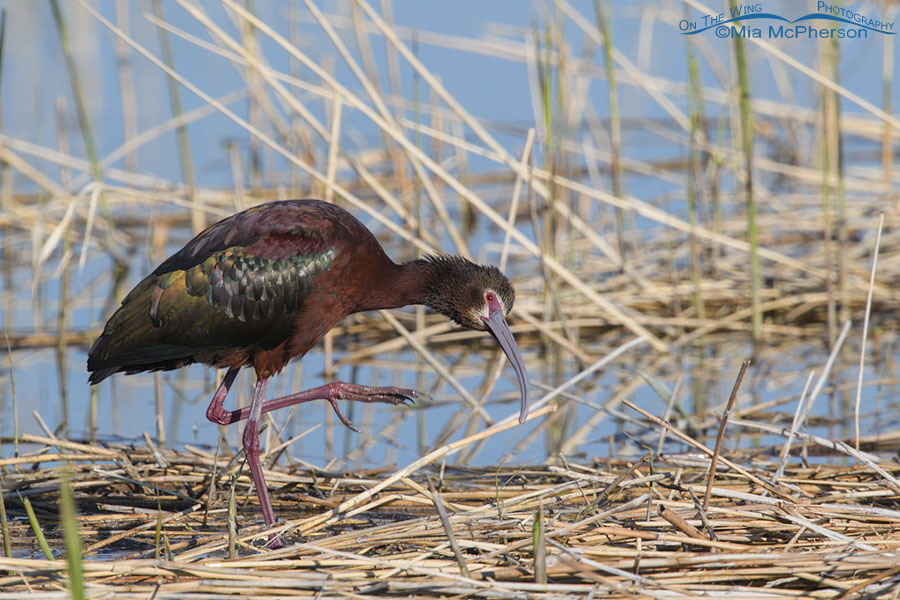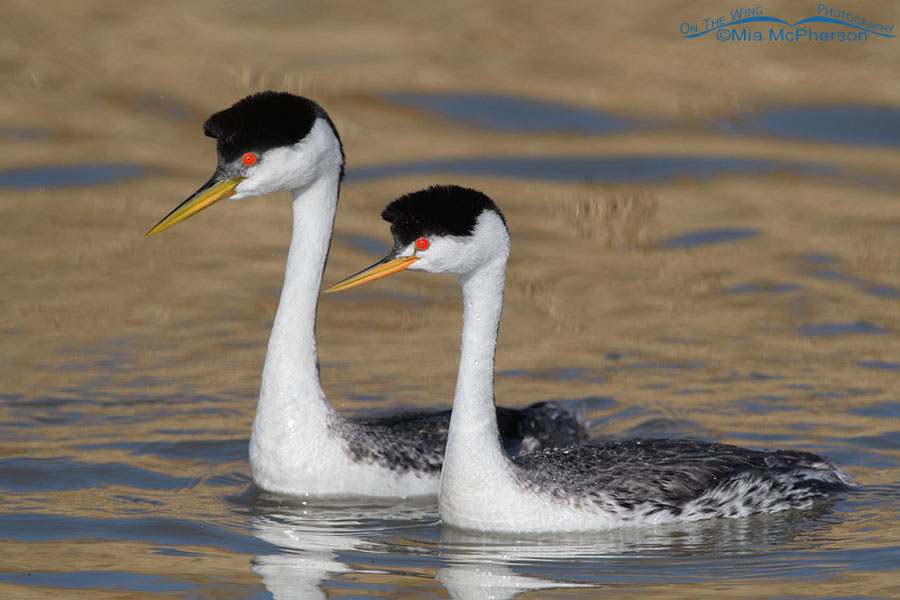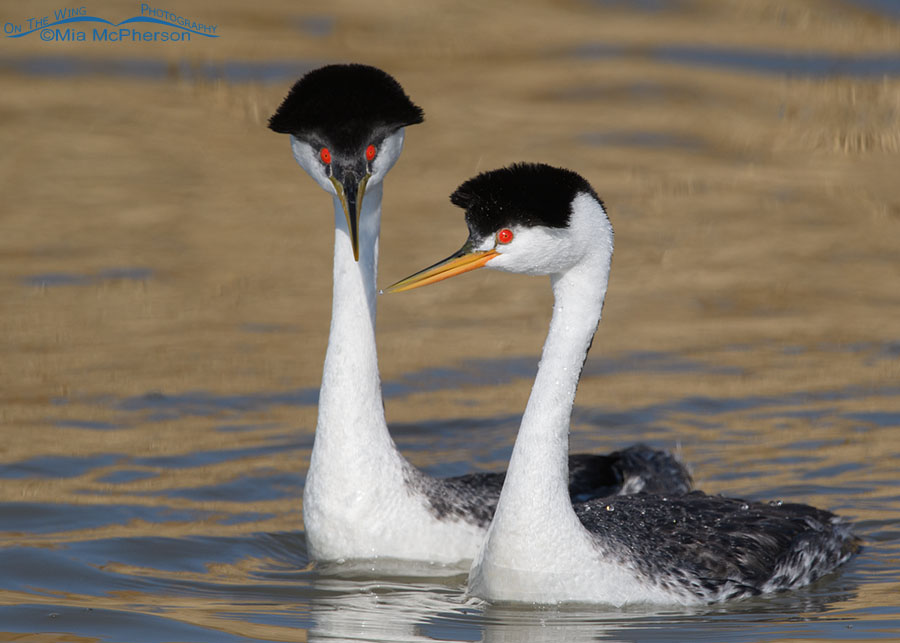Today I wanted to share an assortment of spring birds all photographed at Bear River MBR yesterday on a bright and beautiful morning.
 Displaying male Yellow-headed Blackbird in morning light – Nikon D500, f7.1, 1/640, ISO 500, Nikkor 500mm VR with 1.4x TC, natural light
Displaying male Yellow-headed Blackbird in morning light – Nikon D500, f7.1, 1/640, ISO 500, Nikkor 500mm VR with 1.4x TC, natural light
My photos are in the order that they were taken starting with a male Yellow-head Blackbird in soft, warm light as he displayed next to the road. He was really throwing himself into his display.
 Male Yellow-headed Blackbird with wings raised – Nikon D500, f7.1, 1/640, ISO 500, Nikkor 500mm VR with 1.4x TC, natural light
Male Yellow-headed Blackbird with wings raised – Nikon D500, f7.1, 1/640, ISO 500, Nikkor 500mm VR with 1.4x TC, natural light
When he was finished displaying he raised both his wings over his back before he took flight. The warm light made his dark feathers glow. Throughout the morning I could hear the calls of Yellow-headed Blackbirds practically the entire way around the auto tour route on the refuge.
 Female Red-breasted Merganser on the Bear River – Nikon D500, f7.1, 1/800, ISO 500, Nikkor 500mm VR with 1.4x TC, natural light
Female Red-breasted Merganser on the Bear River – Nikon D500, f7.1, 1/800, ISO 500, Nikkor 500mm VR with 1.4x TC, natural light
I was excited to see Red-breasted Mergansers in several locations yesterday morning. This female was swimming in the river just before I got to the auto tour route.
 Male Red-breasted Merganser on the Bear River – Nikon D500, f7.1, 1/1600, ISO 500, Nikkor 500mm VR with 1.4x TC, natural light
Male Red-breasted Merganser on the Bear River – Nikon D500, f7.1, 1/1600, ISO 500, Nikkor 500mm VR with 1.4x TC, natural light
I also found a male Red-breasted Merganser with her. He isn’t in his breeding plumage but the really dark feathers around his eye indicate that he is a male. Female Red-breasted Mergansers never have those dark feathers around their eyes.
Red-breasted Mergansers do not breed here in Utah. They are just passing through on their way to their breeding grounds.
 Foraging adult male Long-billed Curlew – Nikon D500, f7.1, 1/1000, ISO 500, Nikkor 500mm VR with 1.4x TC, natural light
Foraging adult male Long-billed Curlew – Nikon D500, f7.1, 1/1000, ISO 500, Nikkor 500mm VR with 1.4x TC, natural light
When I spotted this male Long-billed Curlew next to the road on the auto tour route I was happy to get a few photos of him in the green grasses.
 Male Long-billed Curlew foraging in spring grasses – Nikon D500, f7.1, 1/1000, ISO 500, Nikkor 500mm VR with 1.4x TC, natural light
Male Long-billed Curlew foraging in spring grasses – Nikon D500, f7.1, 1/1000, ISO 500, Nikkor 500mm VR with 1.4x TC, natural light
I was even more delighted that the male Long-billed Curlew was so intent on foraging for his breakfast that he walked even closer to where I sat and photographed him from inside a vehicle being used as a mobile blind. Soon after this photo was taken the curlew called, lifted off and headed out into the marsh.
It won’t be long before there will be tiny Long-billed Curlew chicks at the refuge.
 Pair of Sandhill Cranes on the auto tour loop road – Nikon D500, f10, 1/1250, ISO 500, Nikkor 500mm VR with 1.4x TC, natural light
Pair of Sandhill Cranes on the auto tour loop road – Nikon D500, f10, 1/1250, ISO 500, Nikkor 500mm VR with 1.4x TC, natural light
I heard the calls of these Sandhill Cranes before I spotted them standing on the road of the north side of the auto tour route. I was able to take a series of photos of them side by side before they lifted off to join another pair of cranes out in the wetlands close to the road.
 Double-crested Cormorant and Forster’s Terns – Nikon D500, f7.1, 1/1600, ISO 500, Nikkor 500mm VR with 1.4x TC, natural light
Double-crested Cormorant and Forster’s Terns – Nikon D500, f7.1, 1/1600, ISO 500, Nikkor 500mm VR with 1.4x TC, natural light
Shortly after photographing the cranes I spotted and took a few images of my first of the year Forster’s Terns that were resting next to a Double-crested Cormorant. I was delighted to see the terns on the wing and hear their calls over the marshes.
 Adult American White Pelican flock at Bear River – Nikon D500, f7.1, 1/5000, ISO 500, Nikkor 500mm VR with 1.4x TC, natural light
Adult American White Pelican flock at Bear River – Nikon D500, f7.1, 1/5000, ISO 500, Nikkor 500mm VR with 1.4x TC, natural light
I saw American White Pelicans before I got to the auto tour route but didn’t photograph them until I was on the west side of the loop. There were several flocks along that portion of the loop that were in beautiful light. Some of the pelicans were resting, some of them were foraging, and some were simply swimming in the blue waters.
 Adult American White Pelican lift off at Bear River – Nikon D500, f7.1, 1/3200, ISO 500, Nikkor 500mm VR with 1.4x TC, natural light
Adult American White Pelican lift off at Bear River – Nikon D500, f7.1, 1/3200, ISO 500, Nikkor 500mm VR with 1.4x TC, natural light
I was happy to take photos of the pelicans as they lifted off from the cool, sparkling water. They sure make a lot of noise as they take off with their wings and feet slapping the water.
 Spring American White Pelican in flight – Nikon D500, f7.1, 1/3200, ISO 400, Nikkor 400mm VR with 1.4x TC, natural light
Spring American White Pelican in flight – Nikon D500, f7.1, 1/3200, ISO 400, Nikkor 400mm VR with 1.4x TC, natural light
And photos of them as they flew past me with the distant Promontory Mountains in the background.
Recently on social media I have seen a few people state that only the male American White Pelicans have the “horns” on their bills. That is not the case. Both male and female American White Pelicans show the “horns” at this time of the year.
From Birds of the World online:
A highly fibrous, epidermal plate arises vertically and dorsomedially about one third distance from tip of upper mandible, plate (somewhat erroneously termed a “horn”) highly variable in size with base being 40-80 mm and height ranging from barely detectible to more than 60 mm, with that of males in pairs seemingly larger (FLK).
 Still Great Blue Heron in the marsh at Bear River MBR – Nikon D500, f7.1, 1/2500, ISO 400, Nikkor 400mm VR with 1.4x TC, natural light
Still Great Blue Heron in the marsh at Bear River MBR – Nikon D500, f7.1, 1/2500, ISO 400, Nikkor 400mm VR with 1.4x TC, natural light
I also found large numbers of Black-crowned and Great Blue Herons on the west side of the auto tour route. Most of the herons were very skittish but this Great Blue Heron stuck around long enough for me to take a nice series of photos of it.
 White-faced Ibis scratching an itch – Nikon D500, f7.1, 1/1250, ISO 400, +0.3 EV, Nikkor 400mm VR with 1.4x TC, natural light
White-faced Ibis scratching an itch – Nikon D500, f7.1, 1/1250, ISO 400, +0.3 EV, Nikkor 400mm VR with 1.4x TC, natural light
White-faced Ibis were present in large numbers on the north, west and part of the south side of the loop. I was delighted to take photos of this ibis as it scratched an itch. The photo made me giggle which is why I wanted to share this frame.
 Spring Gadwall drake and hen – Nikon D500, f7.1, 1/1250, ISO 400, Nikkor 400mm VR with 1.4x TC, natural light
Spring Gadwall drake and hen – Nikon D500, f7.1, 1/1250, ISO 400, Nikkor 400mm VR with 1.4x TC, natural light
Most of the ducks I saw were still quite wary of vehicles and humans but this pair of Gadwalls stuck around and I was glad to photograph them. Gadwalls are year round residents in northern Utah and this pair will likely soon have a brood of ducklings.
 Clark’s and Western Grebe side by side comparison – Nikon D500, f7.1, 1/2000, ISO 400, Nikkor 400mm VR with 1.4x TC, natural light
Clark’s and Western Grebe side by side comparison – Nikon D500, f7.1, 1/2000, ISO 400, Nikkor 400mm VR with 1.4x TC, natural light
I was over the moon excited when I took a series of photos of Clark’s and Western Grebes that were side by side. In this photo we can see the differences in the dark and white areas of their face and heads plus the differences in the color of their bills.
Clark’s and Western Grebes can really stretch their necks. In this photo the Western Grebe’s neck is stretched out more than the Clark’s.
 Clark’s and Western Grebe close up – Nikon D500, f7.1, 1/2000, ISO 400, Nikkor 400mm VR with 1.4x TC, natural light
Clark’s and Western Grebe close up – Nikon D500, f7.1, 1/2000, ISO 400, Nikkor 400mm VR with 1.4x TC, natural light
I loved this photo that showed the Western Grebe looking towards me head on while I had a nice profile view of the Clark’s Grebe.
These two grebes were simply swimming close to each other. After I photographed them the Clark’s Grebe swam off with another Clark’s Grebe.
 Western Grebe with weeds for the Weed Ceremony – Nikon D500, f7.1, 1/2000, ISO 400, Nikkor 400mm VR with 1.4x TC, natural light
Western Grebe with weeds for the Weed Ceremony – Nikon D500, f7.1, 1/2000, ISO 400, Nikkor 400mm VR with 1.4x TC, natural light
And the Western Grebe? Well one of the pair of Western Grebes dove under the water and came up with a bill full of weeds and it appeared to want to perform the Weed Ceremony. The grebe it was with? It didn’t seem interested at all and kept swimming farther and farther away until this grebe eventually dropped the weeds from its bill and swam after the other bird.
From All About Birds online:
The other display, known as the weed ceremony, is similarly complex but occurs later in the nesting season between a mated pair. The male and female move through behaviors dubbed neck-stretching, bob-shaking, and weed-diving, before coming to the astonishing weed-dancing, in which male and female face each other with aquatic vegetation in the bill and rise up vertically, their feet in constant motion, necks extended and bills rising upward, and then begin spiral movements around one another, their bills gracefully turning as they pivot around their partner.
 Spring female Red-winged Blackbird – Nikon D500, f7.1, 1/2500, ISO 400, Nikkor 400mm VR with 1.4x TC, natural light
Spring female Red-winged Blackbird – Nikon D500, f7.1, 1/2500, ISO 400, Nikkor 400mm VR with 1.4x TC, natural light
I also photographed a female Red-winged Blackbird whose throat was pinkish-orange. The female that was near her didn’t show that wash of colors. That throat coloration is normal for female Red-winged Blackbirds but I don’t see it all that often so she grabbed my attention and I took a long series of images of her.
 Eared Grebe adult on the Bear River – Nikon D500, f7.1, 1/640, ISO 400, Nikkor 400mm VR with 1.4x TC, natural light
Eared Grebe adult on the Bear River – Nikon D500, f7.1, 1/640, ISO 400, Nikkor 400mm VR with 1.4x TC, natural light
After leaving the auto tour route to head back to the interstate I spotted an Eared Grebe swimming and foraging on the Bear River and I was able to take close up photos of it. I was thrilled because the grebe was in full breeding plumage, it was close, and that the light was still okay.
 Spring Eared Grebe floating by on the Bear River – Nikon D500, f7.1, 1/1250, ISO 400, Nikkor 400mm VR with 1.4x TC, natural light
Spring Eared Grebe floating by on the Bear River – Nikon D500, f7.1, 1/1250, ISO 400, Nikkor 400mm VR with 1.4x TC, natural light
Just a couple of hundred yards to the east I was able to take photos of another Eared Grebe where the water of the river looked bluer. There were quite a few other Eared Grebes out in the middle of the river that were too far away to take high quality images of them. Eared Grebes do breed in Utah and I would love to photograph them with their young.
All in all, it was a wonderful and bird-filled morning at the refuge and I came home with more photos than I have taken in a long time.
Life is good.
Mia
Click here to see more of my bird photos.


What a great spread! All of the pics are terrific…but I really loved the Grebe shots. I can never get over how red/orange their eyes are. Beautiful. Thanks Mia.
Fascinating collection of photos, so glad the light and weather and birds all came together for you. Beautiful shots!
Wow! what a selection and what beauty! Thank you!
Wow — what an incredible morning. Thank you for sharing this abundance of avians.
Thank you so very much for sharing an amazing morning.
fabulous!!
Hi Sweetie! Great photos! You do wonderful photos! I really enjoyed looking at them!
Beautiful photos! Looks like a wonderful day! I still have not gone through 2 days worth of photos from BRMBR. Life keeps interrupting my process every time I sit down to work on them. Maybe today?
Thank you for taking us on a tour with you.
It was almost like being there, (except that we weren’t :))
I didn’t realize there was such a diversity of birds there. Lovely
The female red-winged blackbird surprised me. In all my years of photographing birds, I’ve never seen one with any coloration on their face.
Love the birds in breeding plumage
You made my day.
Wow! You wrapped it all up in one day! What do you have left for tomorrow? Thanks’
Oh, my, what a way to start the day! I would have been over the moon with so many of those birds in my viewfinder!